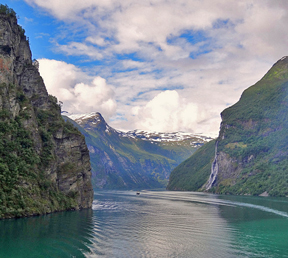Cruising the Norwegian Coast
The Norwegian shipping company Hurtigruten has been moving passengers and freight up and down the coast of Norway in a fleet of ships since 1893. Both Troy and a close friend of ours are of Norwegian descent, and a "roots" cruise has been in the works for years. We've chosen the company's oldest still-sailing ship, the MS Lofoten to obtain a classic sort of a voyage, which will take us from southern Norway, way past the artic circle and around the north cape into the midnight sun. map courtesy Hurtigruten
Norway in a fleet of ships since 1893. Both Troy and a close friend of ours are of Norwegian descent, and a "roots" cruise has been in the works for years. We've chosen the company's oldest still-sailing ship, the MS Lofoten to obtain a classic sort of a voyage, which will take us from southern Norway, way past the artic circle and around the north cape into the midnight sun. map courtesy Hurtigruten
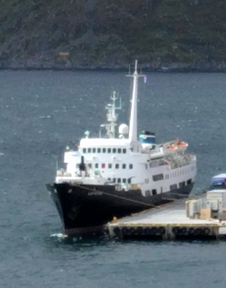
We board Lofoten at Trondheim, after an all-day drive from Ålesund, where we were supposed to be picked up by the ship--but overtime repairs had caused the itinerary to skip that stop. After boarding we check in, and make our way to cabin 215 on C deck, a minuscule, postage stamp space with a porthole about three feet above waterline. Two bunk beds, one which folds down from the wall, a 5-hanger closet space, midget sized en-suite bath, and two-by-two square of floor space for luggage storage complete the space. It will be a challenge to live here for 5 days with the amount of luggage we have for a multi-stage journey. There are better accommodations on board, but apparently they all go to passengers who board at Bergen at the cruise’s start.
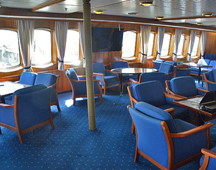 Lofoten’s public spaces are wood paneled, with brass fittings, and polished wood or carpeted floors—much the feel of a small hotel. We pass much time on board sitting in the Panorama Lounge below the bridge, the Polar Lounge on the main and upper deck, or standing on the bridge wing or aft deck, taking in the scenery--which is after all, the primary reason for taking this coastal and inland cruise.
Lofoten’s public spaces are wood paneled, with brass fittings, and polished wood or carpeted floors—much the feel of a small hotel. We pass much time on board sitting in the Panorama Lounge below the bridge, the Polar Lounge on the main and upper deck, or standing on the bridge wing or aft deck, taking in the scenery--which is after all, the primary reason for taking this coastal and inland cruise.
We have a short time to visit Trondheim, and some of us choose to head to the historic center for a walk past the royal palace and quick visit to the Cathedral. Ken and I head to find a breakfast beer in Bryggen, a canal-laced renovated dockland area that had been full of bustling cafes and restaurants the night before. Regrettably, it’s Sunday morning, and everything is shut up tighter than a drum.
Departing Trondheim, the ship sails slowly westward through the forested slopes of Trondheimfjord toward the North Sea and then motors up the coastal and inland waterways. The natural beauty of Norway is certainly what attracts visitors: towering snow-covered peaks, tumbling waterfalls, swaths of conifer and hardwood forests, 
steep-sided fjords and rocky coastline. There is always something new and lovely to gaze at. The rhythm of the cruise is relax, read, look at the incredible coastline we pass, go outside for a field glass view of interesting mountains, islands or towns, have a beer, read some more, gaze at the view again for a while and most every day, depart for some sort of shore excursion. And of course, prepare for meals.
Breakfast and lunch on board are open seating and buffet--pretty much what you’d expect for breakfast, with the addition of smoked fish and different types of herring. The lunch array features a variety of cold meats and 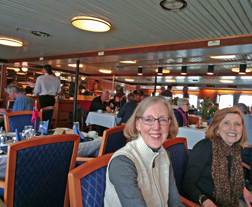 cheeses, prepared salads and pickled vegetables, leafy greens and tomatoes, and an assortment of breads. There are several hot items, but I generally don't find them worthy of consideration. Lofoten’s wine list is surprisingly broad, and not unfairly priced, when one understands the level of tax in Norway.
cheeses, prepared salads and pickled vegetables, leafy greens and tomatoes, and an assortment of breads. There are several hot items, but I generally don't find them worthy of consideration. Lofoten’s wine list is surprisingly broad, and not unfairly priced, when one understands the level of tax in Norway.
Dinner is reserved seating and silver-tray service. Four courses: soup or appetizer, starter, main course and dessert—stuffed crab, cauliflower soup, and shrimp salad all make appearances as starters. There is expectedly a lot of fish—grilled halibut, grayling, salmon, but also reindeer one night, and pork another. The Artic buffet is spread the final night—mussels in cream; dressed brown crab; king crab legs; stone crab claws--partially pre-cracked, as they are so very hard; shell-on shrimp; langoustines; smoked halibut and gravlaks and an array of cold veget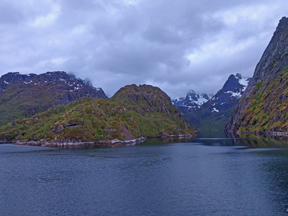 ables, pickles and sides. All the seafood on board is impeccably fresh and delicious.
ables, pickles and sides. All the seafood on board is impeccably fresh and delicious.
There’s an announcement that sometime early in the morning we will cross the Artic Circle, at 66 degrees north latitude, and there is a “crossing pool” – all passengers are encouraged to enter their guess as to the exact time, and the closest guess will win a prize in a ceremony the next night. If one is awake during the crossing, it’s traditional to take a spoonful of cod liver oil dolled out by the Captain. Fortunately, we're not awake.
We motor all night, and early the next day we dock at Ornes, a lovely town with brightly painted wood clapboard houses and snow-capped peaks in the background. A short stop for cargo 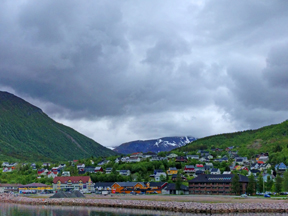 loading and unloading, and then on to Bodo, a good-sized city surrounded by pine and birch forests and still snow-laced peaks for a three hour port-call. The day’s activity is to take the RIB—rubber inflatable boat—“safari”. We are suited in full Polaris lime green waterproof overalls, hoods, goggles and gloves, and climb onto the saddle like seats, crammed like sardines in a can. From the dock, a full boat looks like it contains two green caterpillars.
loading and unloading, and then on to Bodo, a good-sized city surrounded by pine and birch forests and still snow-laced peaks for a three hour port-call. The day’s activity is to take the RIB—rubber inflatable boat—“safari”. We are suited in full Polaris lime green waterproof overalls, hoods, goggles and gloves, and climb onto the saddle like seats, crammed like sardines in a can. From the dock, a full boat looks like it contains two green caterpillars.
The boat races over the chop at 30 knots, bouncing like a bronco. Sights seen over two-plus hours include the strongest tides in the world at Saltstraumen, forming literal whirlpools in the sea surface; open-fjord salmon farms; and some incredible geological formations of heavily striated basalt, ribboned with crossing veins of quartz—looking like gnarly tree roots. We spot a white-tailed sea eagle circling, and on the other side of the bay another sea eagle sitting on a nest, with a tiny head or two occasionally peeking up alongside. The speed on the water with the bouncing from crest to crest is exhilarating--we're sad to end the tour, but also a bit butt-weary.
veins of quartz—looking like gnarly tree roots. We spot a white-tailed sea eagle circling, and on the other side of the bay another sea eagle sitting on a nest, with a tiny head or two occasionally peeking up alongside. The speed on the water with the bouncing from crest to crest is exhilarating--we're sad to end the tour, but also a bit butt-weary.
From Bodo we cross three hours of open Nordic Sea, and make our way up the coast of the dramatically scenic Lofoten Islands, after which the ship is named. The Lofoten archipelago is a stunning lacy chain of islands of lakes, inlets and fjords towered over by soaring peaks. The islands have a strong connection to the Viking age, and there are both a Viking museum, and reconstructed Viking longhouse on Vestvagoy. The ship puts in at Stamsund and Svolvaer to unload and load cargo. This is 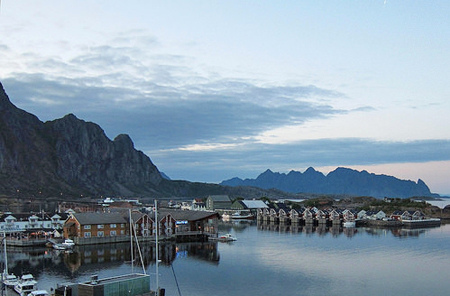 accomplished via a crane on the foredeck moving cargo from the forward hold and the deck itself onto the dock – Lofoten is the last of Hurtigruten’s ships to use this method – all ships coming after use roll-on roll-off containers. Svolvaer is capital of the islands, and center of the dried cod industry. An interesting view in port is of the enormous cod-drying racks, draped with hundreds of sides of fish looking like towels drying in the distance.
accomplished via a crane on the foredeck moving cargo from the forward hold and the deck itself onto the dock – Lofoten is the last of Hurtigruten’s ships to use this method – all ships coming after use roll-on roll-off containers. Svolvaer is capital of the islands, and center of the dried cod industry. An interesting view in port is of the enormous cod-drying racks, draped with hundreds of sides of fish looking like towels drying in the distance.
Late Wednesday night, as we are motoring north through some steep, dramatic cliffsides, Lofoten makes a slow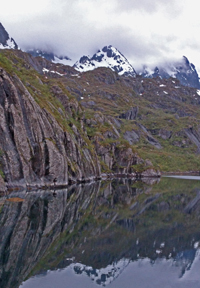 turn to port into the steep and narrow Trollfjord. A spectacular sight at midnight: almost perpendicular thousand meter high rock cliffs, high snow capped peaks in the distance, and threads of mountain waterfalls tumbling into a reflecting sea as calm and smooth as glass. Lofoten barely has a few feet on either side at the narrowest point, and must be the only ship in the fleet that can actually enter Trollfjord.
turn to port into the steep and narrow Trollfjord. A spectacular sight at midnight: almost perpendicular thousand meter high rock cliffs, high snow capped peaks in the distance, and threads of mountain waterfalls tumbling into a reflecting sea as calm and smooth as glass. Lofoten barely has a few feet on either side at the narrowest point, and must be the only ship in the fleet that can actually enter Trollfjord.
In the morning a bridge tour is available, and captain Thor Amundsen explains the ship’s radar and navigation, the ins and outs of the bridge workings, and some details of the intricacies of getting in and out of docks while dealing with wind and current with just the single screw—no bow or stern thrusters to help move sideways. Docking safely in wind involves dropping the anchor early and laying a lot of chain on the bottom, so if the wind starts forcing the ship too fast against the dock, pulling in the chain acts as a brake. Getting back out involves a tight line from the bow, gentle forward thrust with rudder in the direction of the quay, in order to make the boat "turn" in 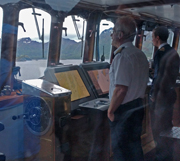 place against the quay side, forcing the stern out.
place against the quay side, forcing the stern out.
A passenger asks if he's related to the explorer, and he replies “when it's convenient....like getting through customs in the US or Canada." He lives in Tromso, where we will dock this afternoon, and much of the crew will change. The crew all spend 22 days on the ship, then have 22 days of shore leave.
Another passenger asks about the worst weather experience on the ship, and Captain Amundsen said there was one storm so fierce that the ship heeled over to the point that both lifeboats were dunked, without their swing-davits having been released. We looked at the lifeboats after the tour, and it seemed pretty clear that all decks save the bridge must have been underwater at that moment.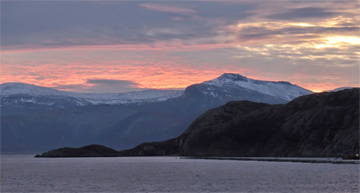
Tromso is the northernmost urban area in Norway, and the biggest city above the Artic Circle. Architecturally, walking down Storgata, the main street, it has the feel of Colorado mining town. The Lutheran Cathedral is a lovely wooden church established in 1861. Three blocks down the street, for the “other religion” sits Ølhallen, the oldest brewpub in town, and perhaps above the Artic Circle, serving beer fermented at the nearby brewery Macks Ølbryggeri. We spend an hour in Polaria, which has an interesting IMax style theater 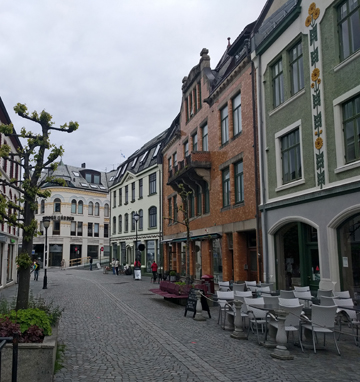 showing gorgeous aerial imagery of the far north. At the other end of town, the Polar Museum catalogues the expeditions of the early explorers to the poles.
showing gorgeous aerial imagery of the far north. At the other end of town, the Polar Museum catalogues the expeditions of the early explorers to the poles.
From Tromso it's out into open sea. Inland waterway cruising has been very calm and stable....a glass of beer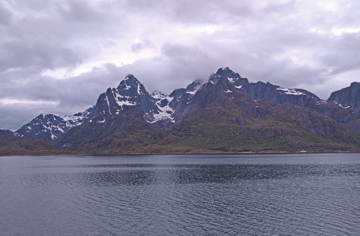 sits on the lounge table unmoving. As Lofoten heads into even small swells—since she has no gyro stabilizers—she begins to pitch and roll a fair amount...maybe ten degrees each axis, and sometimes they combine into a sort of circular movement. One strong roll sends tables full of glasses, books, electronics headed for the floor. That movement continues though the night, and it's a rock-you-to-sleep for some, and a keep-you-from-dropping-off for others, we discover next morning.
sits on the lounge table unmoving. As Lofoten heads into even small swells—since she has no gyro stabilizers—she begins to pitch and roll a fair amount...maybe ten degrees each axis, and sometimes they combine into a sort of circular movement. One strong roll sends tables full of glasses, books, electronics headed for the floor. That movement continues though the night, and it's a rock-you-to-sleep for some, and a keep-you-from-dropping-off for others, we discover next morning.
Honningsvag, the most northern village in Norway, is reached after we round Nordkapp—the north cape, on the island of Magerøya—and the northernmost point of mainland Norway at over 71 degrees north. Only the Norwegian Svalbard Islands are farther north, reaching just over 80 degrees north. 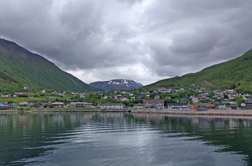 Magerøya is birder’s heaven, and there will be an excursion next morning to the bird cliff of Gjesværstappan, home to hundreds of thousands of puffins, cormorants and gannets. This is stark, barren, landscape. In winter, everything is completely snow covered, but now there are only ribbons of dirty snow in the crevices of un
Magerøya is birder’s heaven, and there will be an excursion next morning to the bird cliff of Gjesværstappan, home to hundreds of thousands of puffins, cormorants and gannets. This is stark, barren, landscape. In winter, everything is completely snow covered, but now there are only ribbons of dirty snow in the crevices of un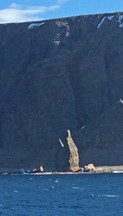 relieved gray-brown undulating cliffs—dramatic, but so different from the scenery further south.
relieved gray-brown undulating cliffs—dramatic, but so different from the scenery further south.
The next jump is Honningsvag to Kjolleford across an open stretch of the Barents Sea. On the way into Kjollefjord, the Lofoten passes one of Norway’s most famous rock formations, Finnkjerka. There are actually two— Store and Lille Finnkjerka (the big and the small Finn Church)—so named because they vaguely of resemble a cathedral shape.
Kjollefjord is a small village with the feel of an Alaska frontier town. A half-hour stroll takes in the three streets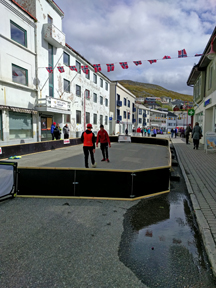 with their muted clapboard houses. On the Main Street from the harbor, school kids are playing makeshift soccer in the road on their lunch break, that being the only flat place in town. Outside those streets the land is fairly desolate rocky tundra. As we’ve said about most of the short port calls: “What do they do here? ....fish. What do they eat here?…fish.
with their muted clapboard houses. On the Main Street from the harbor, school kids are playing makeshift soccer in the road on their lunch break, that being the only flat place in town. Outside those streets the land is fairly desolate rocky tundra. As we’ve said about most of the short port calls: “What do they do here? ....fish. What do they eat here?…fish.
The grand finale: our last night, the clouds are gone, the sky is bright, and we have the chance to experience midnight sun—which actually hits lowest point closer to 1:30 am in early June. For almost three months of summer, the sun this far north never sets, but slowly dips toward the north horizon, grazes just above the edge of the Artic Sea, colors the sea and sky a reddish orange, and then begins to creep upward again into the new day. The writer Knut Hansun described it in the late 1800’s: “Night was coming on again; the sun just dipped into the sea and rose again, red, refreshed, as if it had been down to drink. I could feel more strangely on those nights than anyone would believe”.
